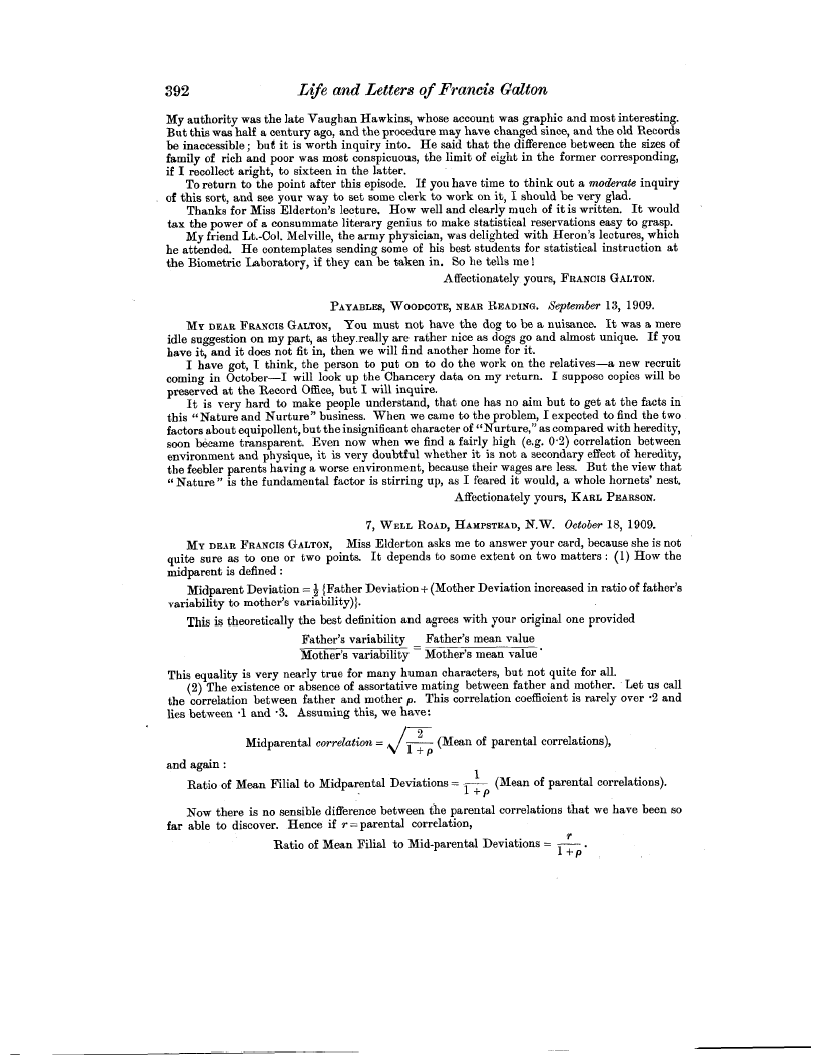| ||||||

OCR Rendition - approximate
392 Life and Letters of Francis Galton My authority was the late Vaughan Hawkins, whose account was graphic and most interesting. But this was half a century ago, and the procedure may have changed since, and the old Records be inaccessible; but it is worth inquiry into. He said that the difference between the sizes of family of rich and poor was most conspicuous, the limit of eight in the former corresponding, if I recollect aright, to sixteen in the latter. To return to the point after this episode. If you have time to think out a moderate inquiry of this sort, and see your way to set some clerk to work on it, I should be very glad. Thanks for Miss Elderton's lecture. How well and clearly much of it is written. It would tax the power of a consummate literary genius to make statistical reservations easy to grasp. My friend Lt.-Col. Melville, the army physician, was delighted with Heron's lectures, which he attended. He contemplates sending some of his best students for statistical instruction at the Biometric Laboratory, if they can be taken in. So he tells me Affectionately yours, FRANCIS GALTON. PAYABLES, WOODCOTE, NEAR READING. September 13, 1909. MY DEAR F&tcis GALTON, You must not have the dog to be a nuisance. It was a mere idle suggestion on my part, as they.really are rather nice as dogs go and almost unique. If you have it, and it does not fit in, then we will find another home for it. I have got, I think, the person to put on to do the work on the relatives-a new recruit coming in October-I will look up the Chancery data on my return. I suppose copies will be preserved at the Record Office, but I will inquire. It is very hard to make people understand, that one has no aim but to get at the facts in this "Nature and Nurture" business. When we came to the problem, I expected to find the two factors about equipollent, but the insignificant character of "Nurture," as compared with heredity, soon became transparent. Even now when we find a fairly high (e.g. 0.2) correlation between environment and physique, it is very doubtful whether it is not a secondary effect of heredity, the feebler parents having a worse environment, because their wages are less. But the view that "Nature" is the fundamental factor is stirring up, as I feared it would, a whole hornets' nest. Affectionately yours, KARL PEARSON. 7, WELL ROAD, HAMPSTEAD, N.W. October 18, 1909. MY DEAR FRANCIS GALTON, Miss Elderton asks me to answer your card, because she is not quite sure as to one or two points. It depends to some extent on two matters : (1) How the midparent is defined Midparent Deviation = 2 {Father Deviation + (Mother Deviation increased in ratio of father's variability to mother's variability)}. This is theoretically the best definition and agrees with your original one provided Father's variability _ Father's mean value Mother's variability Mother's mean value' This equality is very nearly true for many human characters, but not quite for all. (2) The existence or absence of assortative mating between father and mother. - Let us call the correlation between father and mother p. This correlation coefficient is rarely over •2 and lies between •1 and •3. Assuming this, we have: Midparental correlation = Jl 2 (Mean of parental correlations), P and again Ratio of Mean Filial to Midparental Deviations = 1 + A (Mean of parental correlations). Now there is no sensible difference between the parental correlations that we have been so far able to discover. Hence if r = parental correlation, Ratio of Mean Filial to Mid-parental Deviations = 1 + P
|